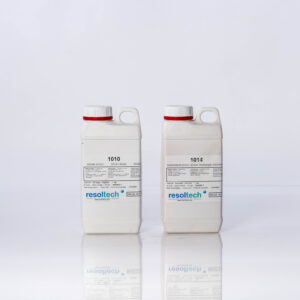Free delivery in Benelux until 10kg.
€ 170,50 HTVA
Solvent-free novolac epoxy coating for high-temperature immersion in acids.
Resimac 206 Ceramic HTA fluid is designed to protect equipment operating in contact with acids and highly aggressive chemicals at high temperatures. Once fully cured, the coating can withstand temperatures of up to 110°C in continuous immersion in sulfuric and hydrochloric acid.
– Apply to abrasive blast-cleaned surfaces
– Withstands continuous immersion up to 110°C (230°F)
– Brushed on in 2 coats
– condensate extraction pumps heat exchanger return tanks
– distillation unit evaporators heat exchangers
– purification units
Metal substrates – Abrasive blasting
1. All oil and grease must be removed from the surface using a suitable cleaner such as MEK.
2. All surfaces must be blast-cleaned to ISO 8501/4 SA2.5 75 microns (3mil) using an angular abrasive.
3. Once stripped, the surface must be degreased and cleaned with MEK or a similar product.
4. All surfaces must be coated before corrosion or oxidation occurs.
NOTE: for salt-contaminated surfaces, the substrate must be pressure-washed with clean water and checked for salt contamination. Please refer to the surface preparation and pre-application guide for further information.
Before mixing, please check the following points
1. The base component is at a temperature of 15-25°C (60-77F°).
2. Ambient and surface temperature above 10°C (50F°).
3. Ambient and surface temperatures not less than 3°C (6°F) above dew point.
Once these 3 checks have been carried out, proceed with mixing the product.
1. Transfer the contents of the Activator unit to the Base container.
2. Using the spatula provided, mix the 2 components until a uniform, streak-free material is obtained.
3. Once mixing has begun, the entire material must be used within 25 minutes at 20°C (68°F).
1. The first layer of material should be applied to a target thickness of 600 microns (24mil). Use a plastic applicator as a squeegee to apply a very thin layer of product, forcing it into the sanding profile.
2. Particular attention should be paid to detailed areas such as edges, corners and welds, where dotted brush application may be required.
3. Immediately after the initial application, apply another coat of product by brush or applicator to achieve the required film thickness, checking with a wet film thickness gauge.
4. Apply the coating with a brush to obtain a smooth finish.
5. Allow to cure for at least 16 hours at 20°C (68F°) before removing all traces of dirt by washing first with a mixture of water and detergent, then with clean water.
6. Then sandblast at reduced pressure with fine grit, removing all debris before washing with MEK. debris before washing with MEK.
7. The second layer of material should be applied to a target thickness of 300 microns (12mil) using a brush or applicator. brush or applicator and check film thickness once more with a wet film gauge before
brush for a smooth finish.
At 20°C (68F°), applied materials must be allowed to cure for the times indicated below before being subjected to the conditions indicated. conditions indicated. These times will be extended at lower temperatures and reduced at higher temperatures:
Service life 25mins
Minimum screening time 16 hours
Maximum blasting time 48 hours
Full cure 3 days
Mixed material – Dark grey, Light grey
Basic component – Dark grey, Light grey
Activator component – Amber liquid
5 years if unopened and stored under normal dry conditions (15-30°C/ 60-86°F)
https://www.resimacsolutions.com/uploads/4/5/0/7/45072315/206_hta_tds.rv3.13052019_1.pdf
https://www.resimacsolutions.com/uploads/4/5/0/7/45072315/206hta_ps.rv3.13052019_1.pdf





RUE J. VAN HOVE, 35 1950 KRAAINEM
Mo-Fr 8:30 - 12:00 / 13:00 - 17:00